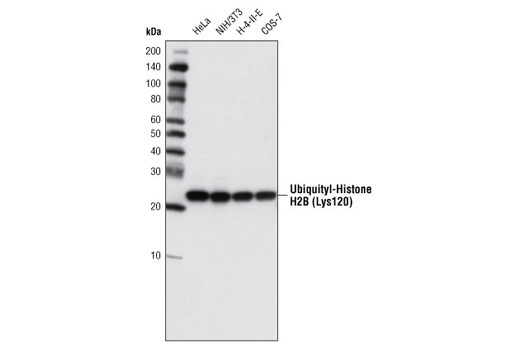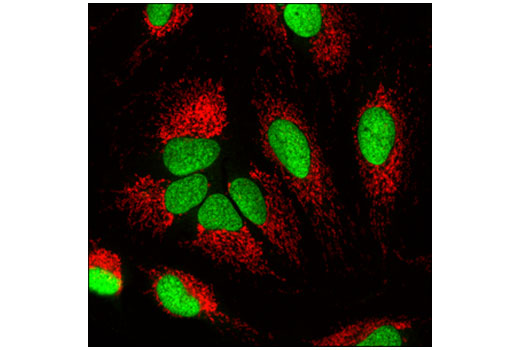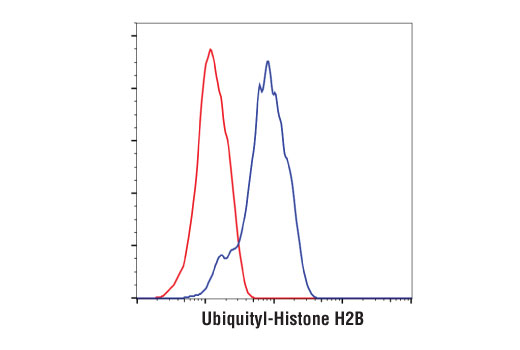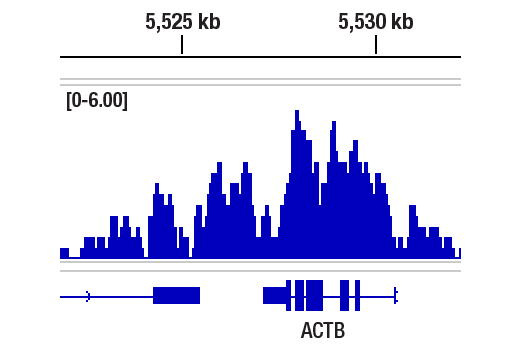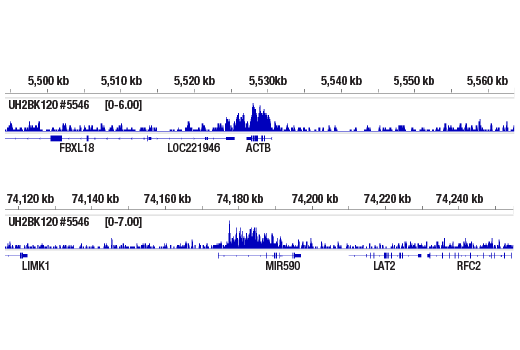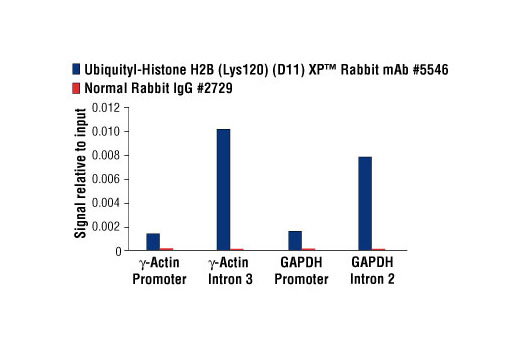WB, IF-IC, FC-FP, ChIP, ChIP-seq
H M R Mk
Endogenous
23
Rabbit IgG
#P33778
3018
Product Information
Product Usage Information
For optimal ChIP and ChIP-seq results, use 2.5 μl of antibody and 10 μg of chromatin (approximately 4 x 106 cells) per IP. This antibody has been validated using SimpleChIP® Enzymatic Chromatin IP Kits.
| Application | Dilution |
|---|---|
| Western Blotting | 1:1000 |
| Immunofluorescence (Immunocytochemistry) | 1:800 - 1:3200 |
| Flow Cytometry (Fixed/Permeabilized) | 1:400 - 1:1600 |
| Chromatin IP | 1:200 |
| Chromatin IP-seq | 1:200 |
Storage
Specificity / Sensitivity
Species Reactivity:
Human, Mouse, Rat, Monkey
Source / Purification
Monoclonal antibody is produced by immunizing animals with a synthetic peptide corresponding to the carboxy terminus of the human histone H2B protein in which Lys120 is mono-ubiquitylated.
Background
The nucleosome, made up of four core histone proteins (H2A, H2B, H3 and H4), is the primary building block of chromatin. Originally thought to function as a static scaffold for DNA packaging, histones have now been shown to be dynamic proteins, undergoing multiple types of post-translational modifications, including acetylation, phosphorylation, methylation, and ubiquitylation (1). Ubiquitin is a conserved 76 amino acid peptide unit that can be covalently linked to many cellular proteins by the ubiquitylation process. Three components are involved in this protein-ubiquitin conjugation process. Ubiquitin is first activated by forming a thiolester complex with the activation component E1; the activated ubiquitin is subsequently transferred to the ubiquitin-carrier protein E2, then from E2 to ubiquitin ligase E3 for final delivery to the epsilon-NH2 of the target protein lysine residue (2). Histone H2B is mono-ubiquitylated on lysine 120 during transcriptional activation by the RAD6 E2 protein in conjunction with the BRE1A/BRE1B E3 ligase (also known as RNF20/RNF40) (3). The RAD6/BRE1 complex is recruited to gene promoters during activation by the PAF complex, an RNA polymerase II-associated protein complex that regulates transcriptional elongation (3-5). Mono-ubiquitylated histone H2B lysine 120 is associated with the transcribed region of active genes (3,6). Mono-ubiquitylation of histone H2B stimulates transcriptional elongation by facilitating FACT-dependent chromatin remodeling (7,8). In addition, it is essential for subsequent methylation of histone H3 lysines 4 and 79, two additional histone modifications that regulate transcriptional initiation and elongation (9). Interestingly, de-ubiquitylation of histone H2B lysine 120 by USP22, a subunit of the human SAGA histone acetyltransferase complex, is a required step in transcriptional activation (10). Thus, it appears that the ubiquitylation state of histone H2B is dynamic during transcription and may serve as an intermediate step in transcriptional activation.
- Peterson, C.L. and Laniel, M.A. (2004) Curr Biol 14, R546-51.
- Liu, F. and Walters, K.J. (2010) Trends Biochem Sci 35, 352-60.
- Kim, J. et al. (2009) Cell 137, 459-71.
- Wood, A. et al. (2003) J Biol Chem 278, 34739-42.
- Xiao, T. et al. (2005) Mol Cell Biol 25, 637-51.
- Minsky, N. et al. (2008) Nat Cell Biol 10, 483-8.
- Pavri, R. et al. (2006) Cell 125, 703-17.
- Fleming, A.B. et al. (2008) Mol Cell 31, 57-66.
- Shilatifard, A. (2006) Annu Rev Biochem 75, 243-69.
- Wyce, A. et al. (2004) Novartis Found Symp 259, 63-73; discussion 73-7, 163-9.
Species Reactivity
Species reactivity is determined by testing in at least one approved application (e.g., western blot).
Western Blot Buffer
IMPORTANT: For western blots, incubate membrane with diluted primary antibody in 5% w/v BSA, 1X TBS, 0.1% Tween® 20 at 4°C with gentle shaking, overnight.
Applications Key
WB: Western Blotting IF-IC: Immunofluorescence (Immunocytochemistry) FC-FP: Flow Cytometry (Fixed/Permeabilized) ChIP: Chromatin IP ChIP-seq: Chromatin IP-seq
Cross-Reactivity Key
H: human M: mouse R: rat Hm: hamster Mk: monkey Vir: virus Mi: mink C: chicken Dm: D. melanogaster X: Xenopus Z: zebrafish B: bovine Dg: dog Pg: pig Sc: S. cerevisiae Ce: C. elegans Hr: horse GP: Guinea Pig Rab: rabbit All: all species expected
Trademarks and Patents
使用に関する制限
法的な権限を与えられたCSTの担当者が署名した書面によって別途明示的に合意された場合を除き、 CST、その関連会社または代理店が提供する製品には以下の条件が適用されます。お客様が定める条件でここに定められた条件に含まれるものを超えるもの、 または、ここに定められた条件と異なるものは、法的な権限を与えられたCSTの担当者が別途書面にて受諾した場合を除き、拒絶され、 いかなる効力も効果も有しません。
研究専用 (For Research Use Only) またはこれに類似する表示がされた製品は、 いかなる目的についても FDA または外国もしくは国内のその他の規制機関により承認、認可または許可を受けていません。 お客様は製品を診断もしくは治療目的で使用してはならず、また、製品に表示された内容に違反する方法で使用してはなりません。 CST が販売または使用許諾する製品は、エンドユーザーであるお客様に対し、使途を研究および開発のみに限定して提供されるものです。 診断、予防もしくは治療目的で製品を使用することまたは製品を再販売 (単独であるか他の製品等の一部であるかを問いません) もしくはその他の商業的利用の目的で購入することについては、CST から別途許諾を得る必要があります。 お客様は以下の事項を遵守しなければなりません。(a) CST の製品 (単独であるか他の資材と一緒であるかを問いません) を販売、使用許諾、貸与、寄付もしくはその他の態様で第三者に譲渡したり使用させたりしてはなりません。また、商用の製品を製造するために CST の製品を使用してはなりません。(b) 複製、改変、リバースエンジニアリング、逆コンパイル、 分解または他の方法により製品の構造または技術を解明しようとしてはなりません。また、 CST の製品またはサービスと競合する製品またはサービスを開発する目的で CST の製品を使用してはなりません。(c) CST の製品の商標、商号、ロゴ、特許または著作権に関する通知または表示を除去したり改変したりしてはなりません。(d) CST の製品をCST 製品販売条件(CST’s Product Terms of Sale) および該当する書面のみに従って使用しなければなりません。(e) CST の製品に関連してお客様が使用する第三者の製品またはサービスに関する使用許諾条件、 サービス提供条件またはこれに類する合意事項を遵守しなければなりません。
